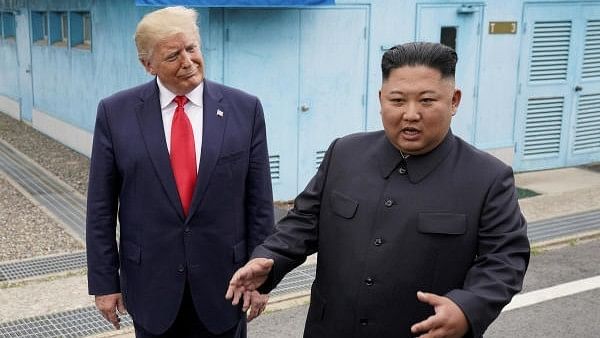
US President Donald Trump meets with North Korean leader Kim Jong Un at the demilitarized zone separating the two Koreas, in Panmunjom, South Korea.
Credit: Reuters Photo
By Karishma Vaswani
The deployment of North Korean troops to Russia to support its war efforts in Ukraine has pushed Asia into dangerous territory. It has ratcheted up already heightened hostilities between North and South Korea and threatens to destabilize the wider Indo-Pacific region. The US, under President-elect Donald Trump’s leadership, will need to find a way to tone down the actions of the increasingly belligerent North Korean leader Kim Jong Un.
For Kim, this deal with Russia makes perfect sense. In September, he vowed to bolster the country’s nuclear weapons capabilities, as a form of deterrence against the South. The two Koreas are still technically at war, having never officially signed a peace treaty when the Korean War ended in 1953.
Moscow can help with Kim’s ambitions, providing much-needed know-how and technology, as South Korea’s Defense Minister Kim Yong Hyun recently noted. In return, it gets manpower on the battlefield, as it faces mounting casualties in the nearly three-year conflict.
This partnership sets an alarming precedent for security in the region. Pyongyang’s military is one of the world’s largest, with 1.3 million active soldiers and an additional 7.6 million on reserve — all in, around a third of its population — but they have little actual combat experience. The Korean People’s Army last experienced large-scale conventional combat in 1953 during the Korean War. The Institute of War notes that US military intelligence assessments indicate that Pyongyang’s strategies for ground operations have remained the same since the 1950s. Its priorities are predominantly centered on striking South Korea, which has rapidly modernized its own forces.
Credit: Bloomberg
Fighting a war in real time could give Pyongyang’s untested forces hands-on practice: A dress rehearsal for a conflict with its hated neighbor. Russia could even help modernise Kim’s outdated submarine fleet, further enhancing his military options.
For Seoul, this is a nightmare scenario. It has only sent economic and humanitarian aid to Ukraine so far, but North Korea’s involvement could push it to change course. For that to happen, the country’s Foreign Trade Act would need major legislative revisions — it currently bans the sending of lethal weapons to active conflict zones, with exceptions for peaceful use.
There are other concerns for South Koreans, like the possibility of Russian forces assisting North Korea in any future conflict. The countries signed a new security pact at a summit in June that requires them to assist if the other is attacked.
Kim is getting increasingly aggressive. Just this week, his regime fired multiple short-range ballistic missiles off its east coast, hours ahead of the US election. On Oct. 31, it fired an intercontinental ballistic missile that Kim claims flew longer than any previous one tested by his regime. It was a reminder that Pyongyang’s ambitions extend well beyond the Korean Peninsula.
Washington has been put on notice. Trump has dealt with Kim before, but that relationship ended badly with the collapse of the Hanoi Summit in February 2019. Since then, North Korea has adopted a more aggressive nuclear doctrine, forged ahead with its missile and satellite technology ambitions, improved its cyber capabilities, and boosted political ties with Russia and China.
For key US ally Japan, Kim’s missiles pose another strategic threat, at a time when it is also focused on Beijing’s increasing assertiveness in the East China Sea. It holds claims over a set of islands known as the Senkakus administered by Japan, and the Diaoyu in China. Tokyo also needs to manage a Russian challenge to the Kurile islands, while helping Washington support Taiwan and navigate tensions in the South China Sea.
The current methods to punish Pyongyang and Moscow — sanctions and financial penalties — aren’t working. Trump has boasted about his personal rapport with the reclusive Kim, revealing in a recent interview that he’d encouraged him to “relax” and “go to the beach,” instead of building up his weapons stockpile. He’s used their previous camaraderie as a way to broker three meetings during his first term. It’s debatable whether that will be enough to get Kim to stand down, especially after the attempts during the Hanoi Summit to persuade the North to trade all its nuclear weapons, material and facilities for an end to US-led sanctions. “Trump gave Kim the best possible offer on the table at the time,” Drew Thompson, senior fellow at the S. Rajaratnam School of International Studies at Nanyang Technological University, told me. “If Kim didn’t take that deal then, it’s hard to see what else Trump would be willing to offer.”
Washington needs to focus on breaking up the bromance between Russia and North Korea and accept, as my colleague Gearoid Reidy has argued, that Pyongyang is already a nuclear state. Closer ties with Tokyo and Seoul are necessary too, particularly on coordination, intelligence-sharing and monitoring. Trump’s America First policy rattled allies about the US’s security commitments in Asia. He should abandon those isolationist ideas and continue key US initiatives like trilateral cooperation with South Korea and Japan to deter North Korea.
Kim’s willingness to intervene in distant conflicts underlines the urgency for coordinated international action to contain his ambitions. The isolated regime fell off President Joe Biden’s radar. The next president must work to contain the threat of a precarious new front from emerging in the Indo-Pacific.